*This post may contain affiliate links. Read more »
Hari Mirch Ka Achar is a traditional Indian green chili pickle that will ignite your meals with its fiery spiciness and fresh aroma. This condiment is a beloved staple in Indian households, adding a burst of tangy, salty, and spicy goodness to every meal.


Enter your email & I'll send it to your inbox. Plus, get great new recipes from me every week!
By submitting this form, you consent to receive emails from Cinnamon Snail.
It is a time-honored tradition to make this pickle during the summer months when hard mirch green chilies are abundant and at their freshest. The process involves preserving the chilies in a medley of aromatic spices, salt, and a touch of garlic, resulting in a harmonious balance of pungent flavors.
From simple dal tadka and coconut rice to subjis like kala chana, or Punjabi dry bhindi and street food snacks like onion bhaji and vadai, Mirchi Ka Achar adds a zingy kick that skyrockets the meal to another level altogether.
Prepared with love and care, each household and region in India has its own unique twist on the recipe. Some prefer a chunky texture with whole chilies, while others opt for a finely ground paste. The variations are endless, but the essence remains the same – a burst of flavor that balances the more typically heavily cooked flavors of Indian cuisine.
The recipe that follows will guide you through the steps, providing you with the tools to create your very own batch of spicy, heavenly goodness.
Jump to:
🥰Why you'll adore this hari mirch ka achar recipe
✊Vegan and Gluten-Free:Like all of my vegan Indian recipes, this green chili pickle contains no animal-based ingredients, gluten, onions, or garlic. Long story short, this makes the condiment perfectly sattvic for everyone, including bhoga for the Supreme!
💣A Fiery Flavor Bomb: Green chili pickle puts a little gunpowder into anything you put it on. Be it a humble bowl of veg biryani and masoor dal, or a bowl of cool olan, a spoonful of hari mirch ka achar makes nothing in your whole life boring ever again. Go ahead, dump it into your calculus textbook, and see how boring that is anymore…
✅Tested and Approved Worldwide: Like all of the vegan recipes I share, my pickle recipes have been tried, tested, and loved by hendreds of recipe testers worldwide.


🥒 Learn to make amazing pickles and ferments
This guide to my most popular pickle recipes is 100% FREE, & you'll love the actual heck out of it 🥰
🌶️ Ingredients for Indian green chili pickle

Green Chilies (Hari Mirch)
Thin green chilies are a staple ingredient in Indian cuisine, known for their vibrant color and fiery heat. I use them to bring some extra heat to my gajar ka achar, arbi sabji, and phool makhana sabji. Rich in vitamins A and C, green chilies also offer a boost of antioxidants. If you prefer medium heat, you can substitute with jalapeños or serrano peppers.
Pickle Masala
Pickle masala is a blend of aromatic spices that brings depth and complexity to the pickle. It typically includes spices like fenugreek, cumin, mustard seeds, turmeric, and asafoetida. To create your own homemade pickle masala, you can follow my easy and fast achar ka masala recipe. Alternatively, you can find ready-made pickle masala in Indian grocery stores or online.
Mustard Oil
Mustard oil, once the dominant cooking oil in India, is still very popular. It is rich in monounsaturated fats and omega-3 fatty acids, making it a healthier alternative to other cooking oils. However, if you cannot find mustard oil or prefer a milder taste, you can substitute it with a neutral-flavored oil like sunflower or avocado oil.
➡️Remember, when working with mustard oil, it's essential to heat it until smoking before adding it to the pickle mixture. This process helps to reduce the strong pungency and raw taste, resulting in a more balanced flavor.
See the recipe card at the bottom of the page for exact quantities and cooking directions.
🤯 Chilli Pickle Variations
Here are a few ways to tweak this recipe to your criminally insane culinary mind’s whim:
Sweet Green Chilli Pickle Recipe
For those who enjoy a balance of sweet and spicy flavors, consider adding a touch of sweetness to the pickle. You can include a tablespoon of jaggery or brown sugar while preparing the pickle masala. A small spoonful of turmeric powder is nice here too, especially if you are using yellow mustard seeds to keep the color vibrant.
Tamarind Mirchi Achar Recipe
To add a tangy twist to the pickle, incorporate tamarind pulp (not TAMARIND CONCENTRATE, which you can use for making things like tahu goreng and banh trang tron) into the recipe. Tamarind's natural acidity complements the spiciness of the chilies and adds a pleasant tanginess. You can soak a small amount of tamarind pulp in warm water and extract the juice, then mix it with the pickle masala before adding it to the chilies. Adjust the quantity according to your desired level of tanginess.
Spicy Mango Pickle
I have a complete mango pickle recipe on the blog, but this is something different. Add slices of green mango to the chilies when you ferment them. You can also add small pieces of amlaki fruit to make it even more sour. Mixed green pickles like this are popular in northern India.
📖 How to make green chilli pickle
You wanna see how actual fire gets made? I will walk you through the whole process. Or you can follow along with the easy-to-print recipe card towards the bottom of this page.

Step 1
Prepare the Chilies and Garlic:
Start by thoroughly washing the green chilies (hari mirch) and drying them completely on a clean kitchen towel.
Remove the stems from the chilies. If you're substituting serrano or jalapeño peppers, slice them into thin rounds.
Peel the garlic cloves and thinly slice them.

Step 2
Grind the Mustard Seeds:
Use a spice grinder or a mortar and pestle to grind the brown or yellow mustard seeds and other pickle masala until they form a coarse powder.

Step 3
Combine the Ingredients:
In a mixing bowl, combine the green chilies, sliced garlic, ground spices, salt, and lemon juice. Mix thoroughly to ensure all the ingredients are evenly distributed.
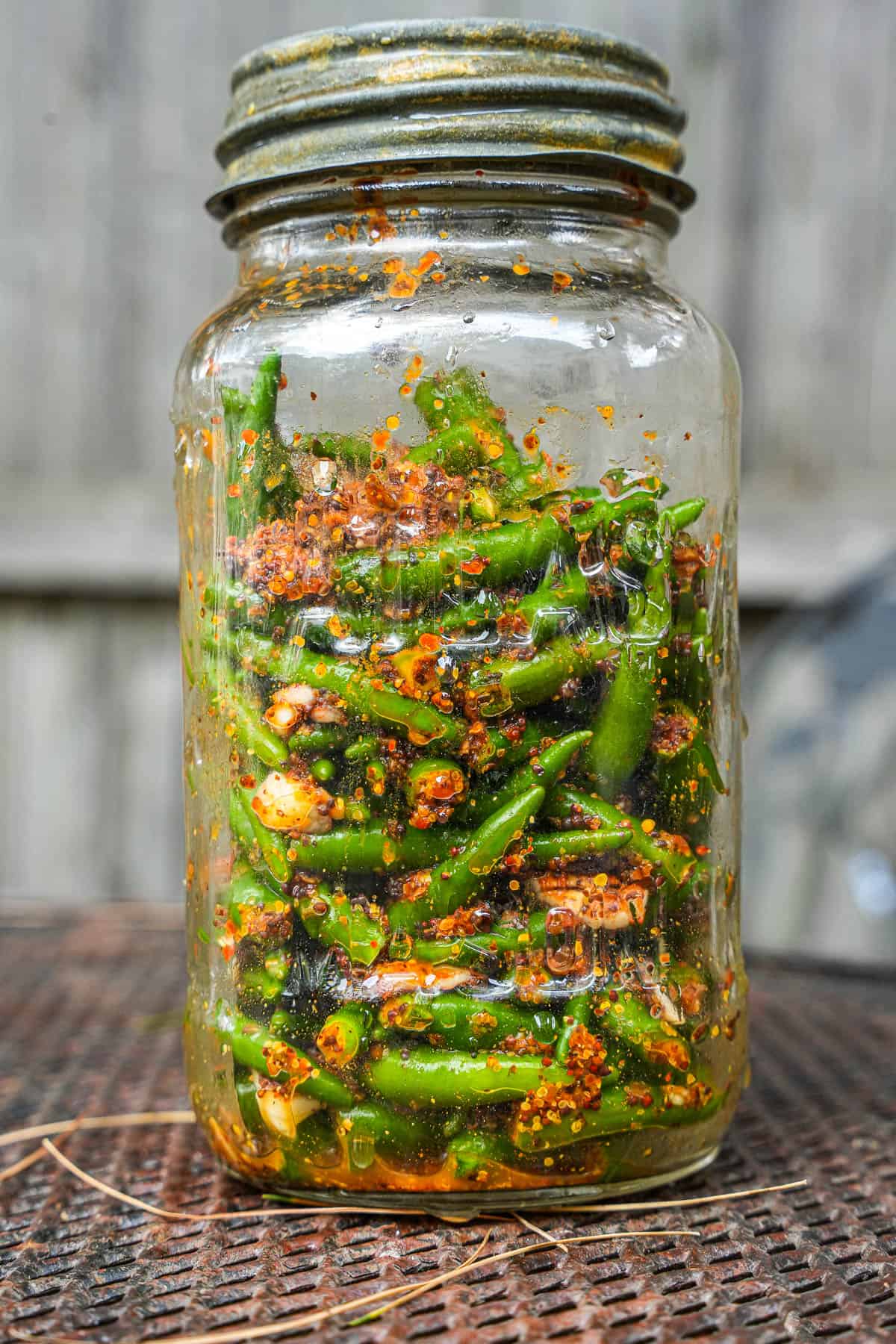
Step 4
Pack the Pickle:
Prepare a clean, sterilized glass jar to store the pickle. You can sterilize the jar by washing it with hot soapy water and then rinsing it with boiling water or running it through a high-temperature dishwasher cycle.
Transfer the mixture to the sterilized jar and firmly press it down with a clean, dry metal spoon.
Ferment the green chilli pickle:
Close the jar tightly with an airtight lid and store it at room temperature for two days. If you have used thicker peppers like jalapeños, you may need to give it an extra day for the peppers to soften further during fermentation.

Step 5
Add the Oil:
After the fermentation period, it's time to add the oil. If you're using mustard oil, heat it in a pan until it reaches the smoking point. Allow the oil to cool for about 20 minutes before adding it to the pickle. This reduces mustard oil’s bitter flavor.
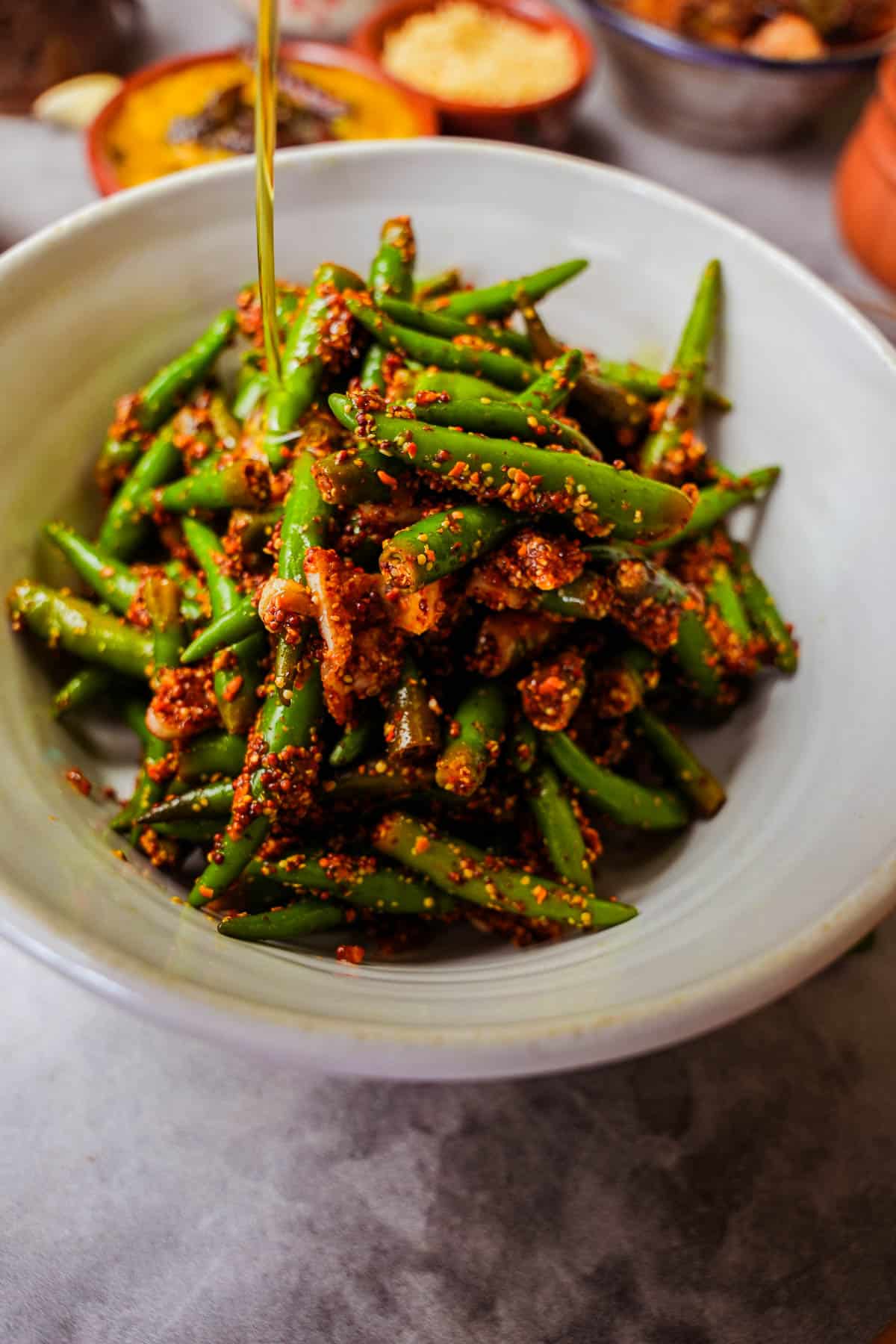
Step 6
If you're using peanut or vegetable oil, you can directly add it to the pickle without heating.
Dump the chilies into a bowl and pour the mustard oil into the pickle mixture. Mix well to ensure all the ingredients are coated with the oil, distributing the flavors evenly.
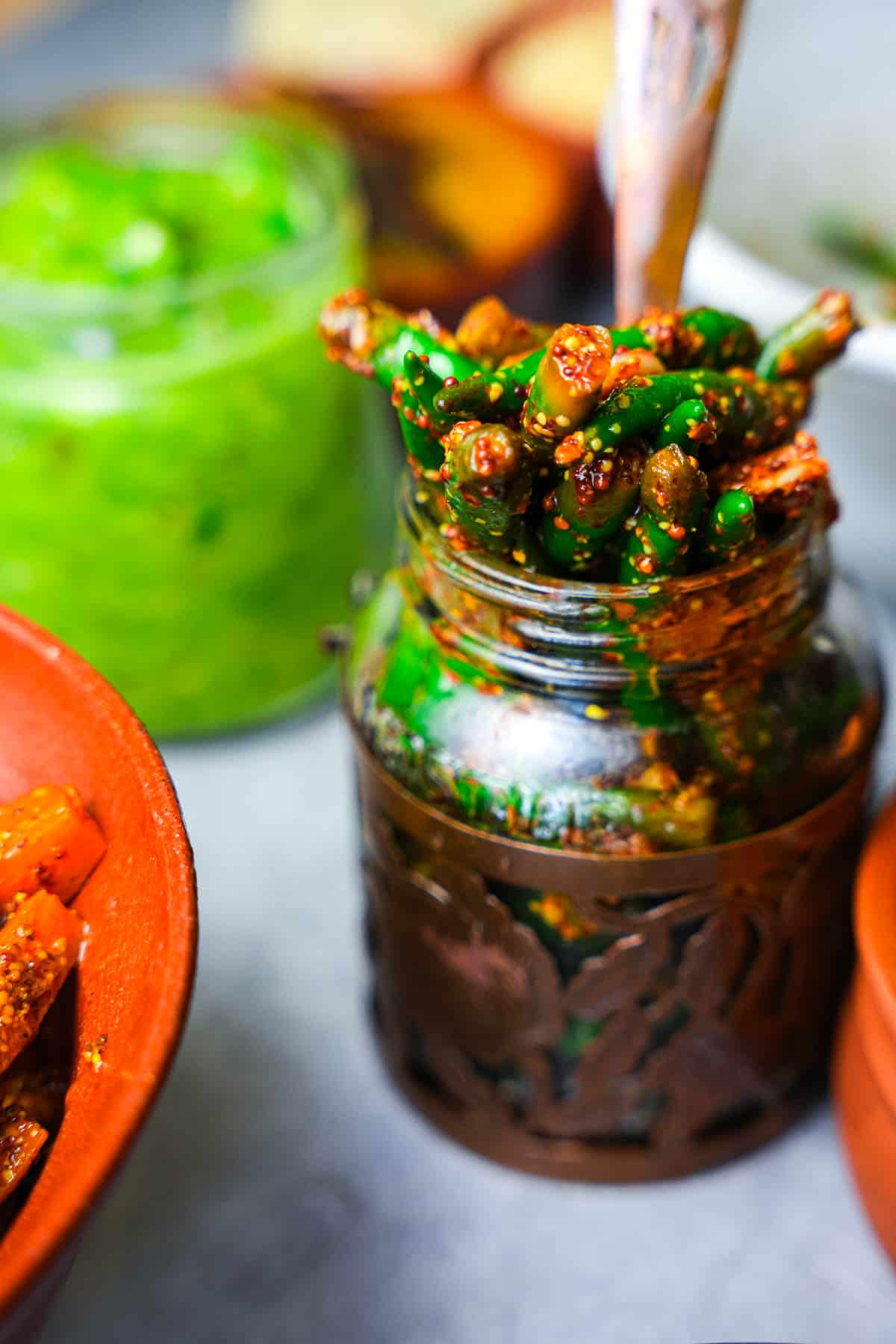
Step 7
Ripen the Pickle:
Although the pickle is ready to be enjoyed at this stage, just like when you make amla pickle, it is recommended to let it ripen further under refrigeration for a day or two. This resting period allows the flavors to develop further and intensify. Use the pickle within two months of making it.
🍽️Serving Ideas
This hari mirch achar recipe makes everything better and spicier! Here are some suggested dishes to have it with:
Serve a generous spoonful of Green Chili Pickle alongside a comforting bowl of masoor dal, or chana dal served over fragrant biryani or aromatic aged basmati pilau with my vegan butter chicken (made with my from-scratch homemade seitan).
Add a vibrant spicy touch to your chaat spread by serving green chili pickle alongside medhu vada, or sweet potato chaat covered in sev and pomegranate seeds.
Upgrade the flavors of your favorite sabjis with a spoonful of spicy pickle. Whether it's veggie-packed aviyal, the Sadhya classic olan, comforting lauki sabji, ridge gourd kootu, parval sabji, aromatic saag aloo, the pickle adds a tangy and spicy twist, taking your sabjis to the next level.
Complete your vegan Indian feast with fluffy and flavorful potato kulcha, flaky Kerala parotta, Moroccan msemen, or freshly grilled homemade pita bread.
Add chili pickle to vegan Middle Eastern classics like oyster mushroom shawarma, vegan kofta, Turkish lentil soup, or stewed Moroccan white beans.

👉Top tips
To ensure the perfect outcome for your Green Chilli Pickle, here are the three most important tips:
- Mustard Oil Refining: Mustard oil has a bitter flavor which can be reduced by heating it to the smoking point over high heat and then cooling it before adding it to the pickles. If you use vegetable oil or peanut oil, this step is not necessary.
- Chili Cleaning: Wash and thoroughly drying the green chilies is crucial. Dirt on the chilies and moisture can contribute to the growth of bacteria and spoilage. So, take the time to thoroughly dry the chilies after washing them to prevent any unwanted microbial activity.
- Jar Sterilization: Before transferring the pickle mixture into the storage container, ensure it is clean and sterilized. Washing it with hot soapy water and rinsing it with boiling water or running it through a dishwasher cycle helps eliminate any potential bacteria. Sterilizing the container ensures a clean environment for fermentation and helps extend the shelf life of the pickle.
- Don't give yourself a tummy ache: go easy! Too many chilies can give some people indigestion. If that happens, cool things down with some candied amla to soothe your stomach.
By following these tips, you can enhance the flavor, quality, and longevity of your Indian Green Chili Pickle, ensuring a perfect result that you can savor and enjoy.

🤷♀️FAQ
Yes, you can omit the garlic in this recipe to make it sattvic, adhering to a traditional yogic diet that avoids pungent ingredients, which cannot be offered as bhoga in many traditions.
While it is best to store the pickle in glass jars, you can use food-grade plastic containers specifically designed for pickling if they are clean, dry, and airtight. Make sure the containers are not scratched internally, as bacteria can develop in the hard-to-clean spots.
Yes, Hari Mirch ka achar is vegan as it does not contain any animal products, and it is also gluten-free, provided that the pickle masala doesn’t contain hing that uses wheat starch in it.
❄️Refrigeration: After making the Indian Green Chili Pickle, it is important to store it in the refrigerator. The cool temperature helps to maintain its freshness and prolong its shelf life.
🫙Proper Container: Choose a storage container that is clean, dry, and airtight. It is essential to avoid containers that could harbor bacteria if scratched. Opt for glass jars or food-grade ceramic containers.
🥶Avoid Freezing: It is not recommended to freeze the Green Chili Pickle. Freezing will wreak havoc on the texture and flavor of the pickle.
🙅♀️💦Moisture Prevention: Condensation or moisture can lead to the growth of bacteria and mold, compromising the quality and safety of the pickle. Ensure your jar has a good seal on it, and always use a clean, dry spoon to take out the pickle and avoid introducing moisture into the storage container.
✌️My faves to serve with this hari mirch achar recipe:

Hari mirch ka achar (Indian green chili pickle)
Equipment
Ingredients
- 250 grams green chili (hari mirch) just over ½ pound
- 4 cloves garlic
- 2 tablespoons mustard seeds yellow, brown or black
- 4 teaspoons pickle masala
- ¾ teaspoon salt or to taste
- 1 tablespoon lemon juice
- ¼ cup mustard oil or vegetable oil, or peanut oil
Instructions
- Prepare the Chilies and Garlic: Wash and thoroughly dry the green chilies (hari mirch). Remove the stems and either pickle them whole or chop them into small pieces. Peel and thinly slice the garlic cloves. If you are substituting serrano or jalapeño peppers, slice them into thin rounds.
- In a spice grinder or mortar and pestle, grind the mustard seeds with the pickle masala until they form a coarse powder.
- In a mixing bowl, combine the chopped green chilies, minced garlic, ground spices, salt, and lemon juice. Mix well until all the ingredients are evenly combined.
- Transfer the mixture to a clean, sterilized glass jar (see notes below about sterilization) with an airtight lid. Press the mixture down into the jar firmly with a clean, dry metal spoon. Close the jar tightly and store it at room temperature for two days. If you use thicker peppers like jalapeños, you may need to give it an extra day for the peppers to soften more.
- After the fermentation period, add the oil. If you are using mustard oil, heat the oil to the smoking point and then allow it to cool for 20 minutes before adding it. This will reduce the bitter flavor of the oil. If you are using peanut or vegetable oil, heating the oil is not necessary.
- Open the jar and add mustard oil to the pickle mixture. Mix well to ensure all the ingredients are coated with the oil.
- Once the mustard oil is mixed in, the pickle is ready to be enjoyed. However, it is recommended to let it rest for a day or two to allow the flavors to further develop. Store the pickle in the refrigerator and use it within two months. Remember to use a clean, dry spoon each time, so as not to introduce moisture or bacteria that could shorten the pickle’s shelf life.
Notes

Enter your email & I'll send it to your inbox. Plus, get great new recipes from me every week!
By submitting this form, you consent to receive emails from Cinnamon Snail.


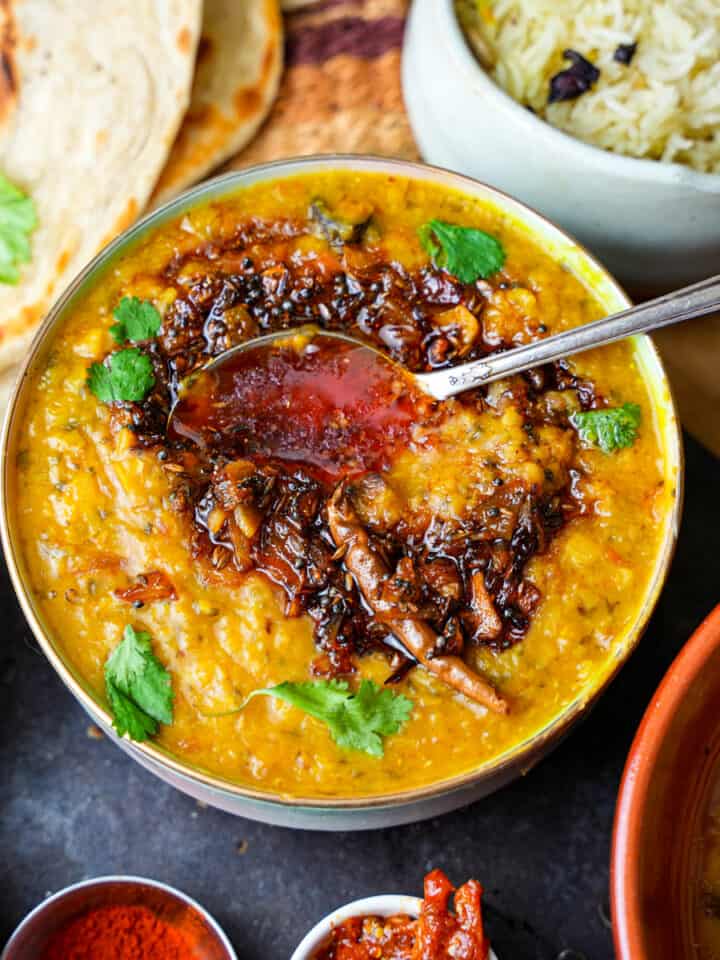





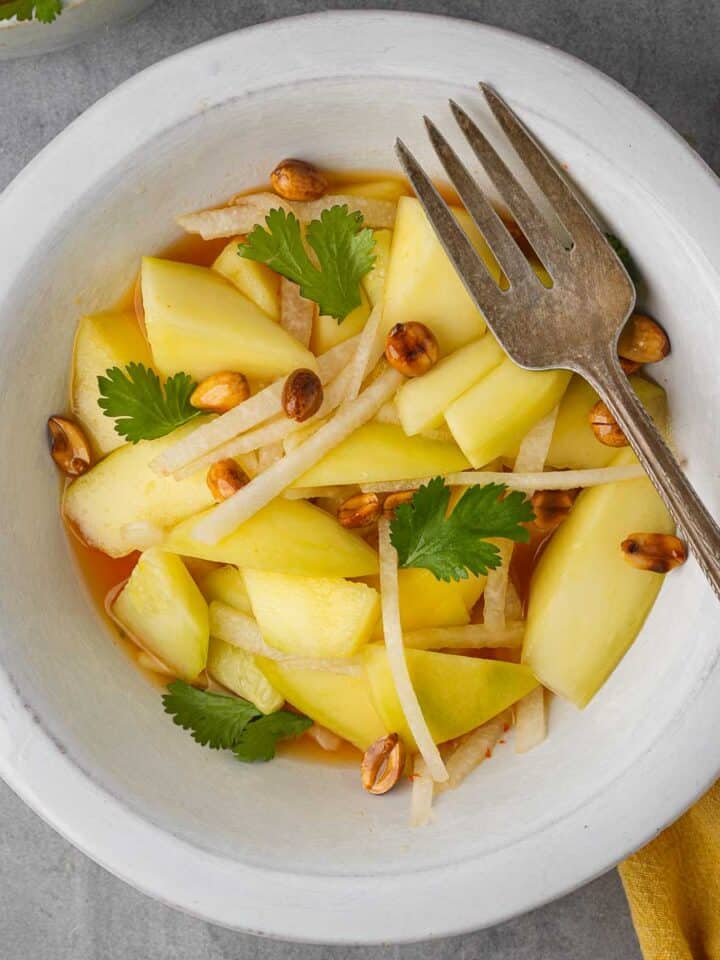
Leave a Reply